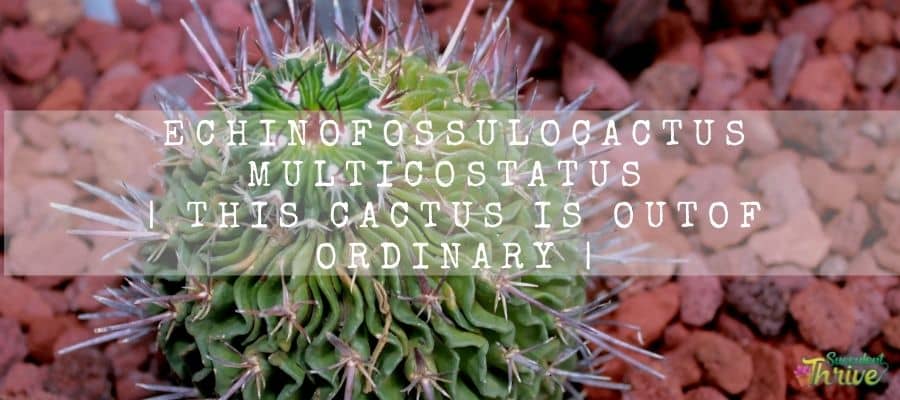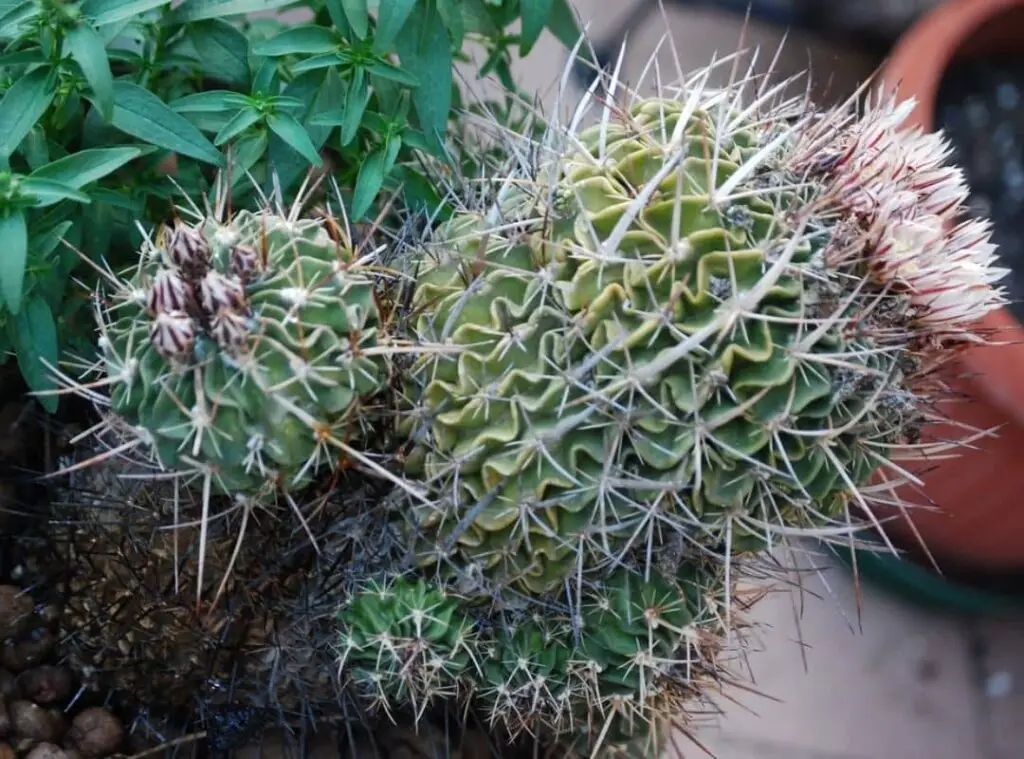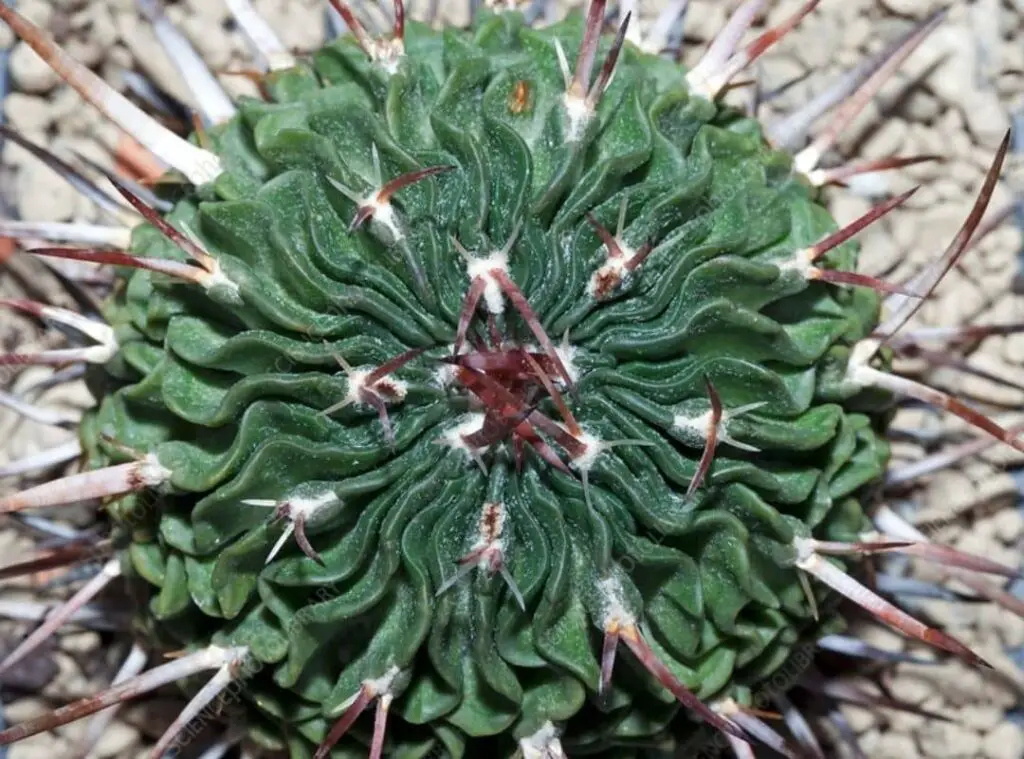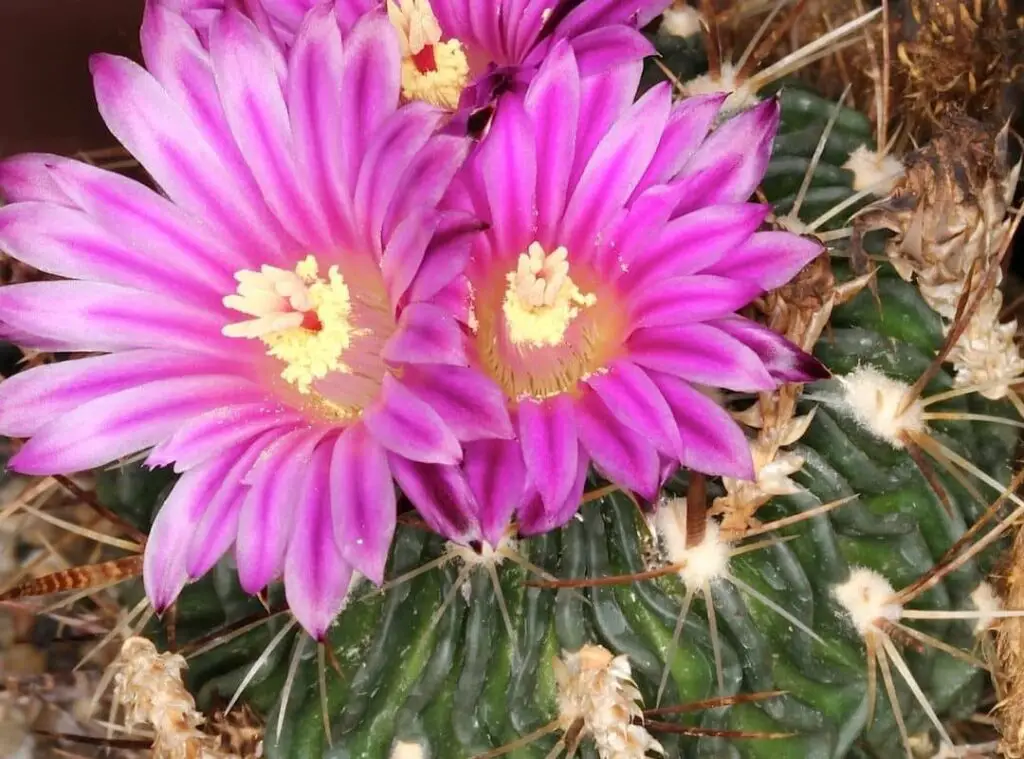Echinofossulocactus multicostatus is a unique spiky cactus. It is more often known as Stenocactus Multicostatus.
So, this article is about the tips you need to practice when looking after these precious plants.
Echinofossulocactus multicostatus are native plants in Mexico. Their habitat are in grassy, high meadowlands.

When it is the drought times, you can see them being grown in the rocky soil. Some of the commonly called names of these cacti are wave cactus, brain cactus. Multicostatus literally means multiple ribs.
Their low maintenance, attractive looks are two interesting features of the Echinofossulocactus multicostatus cactus and due to that many people like to grow them in containers.
They will be the spotlight in your garden when you add them in your garden. Echinofossulocactus multicostatus is a low growing cactus and you can grow them indoors as well.
If you are ready to start growing the Echinofossulocactus multicostatus cactus, keep reading this article. I will be covering the right care tips you should do, the modes of propagating them and the common bugs and illnesses they may come across.
How do I identify Echinofossulocactus multicostatus?
Just like the name Echinofossulocactus multicostatus, it consists of narrow ribs. A mature plant will consist of about 100 ribs.
Those densely grown ribs are wavy. Having said that, chances are that you could spot them forming straight. There will be 2-3 areolas which belong to each rib, and they will have about 6-9 spines as well.
The base of the Echinofossulocactus multicostatus spines would be gold. However, the ends of the spines would be brown.
They would take different sizes of 5 mm-8 mm. Besides, their lower spines are small. On the other hand, the upper spines would be longer and wider. The upper spines would grow in an erecting manner where the lower spine grows in a downward manner.
Echinofossulocactus multicostatus will consist of about 4-9 radial spines. Further they will have about 4 central spines.
The central spine is creamy white to copper brown in color. If you look at the overlook of them, it would tend to take a crosswise look.
Echinofossulocactus multicostatus are unique in their looks. The young Echinofossulocactus multicostatus cactus will be carrying felt.
Hence they are called as white cacti. They will have a globular shape and you could spot them forming in gray – green to deep green. Once they mature, they will form in a cylindrical shape.
Echinofossulocactus multicostatus stems would be about 6-15 cm wide and 6-12 cm tall. They are depressed, spherical to shirt cylindrical aforesaid.
Echinofossulocactus multicostatus would reach a maximum height of 12 cm. They would be growing as solitary plants.
However, you may also spot them forming in 2-3 stems as well. Echinofossulocactus multicostatus produces flowers which are delicate.
Those blooms would be about 2-3 cm in diameter. You can spot them forming in pink, purple or in white. They will comprise a short tube and their blooming season would be usually spring and summer.
Growth rate
Echinofossulocactus multicostatus cactus are slow growing cactus.
One look care guide
| Botanical Name | Echinofossulocactus multicostatus |
| Common Name | Wave cactus, Brain cactus |
| Plant Type | Cactus |
| Mature Size | maximum height of 12 cm |
| Sun Exposure | Full sunlight to light shade |
| Soil Type | Well draining |
| Soil pH | Neutral |
| Bloom Time | Spring and summer |
| Flower Color | pink, purple or in white. |
| Hardiness Zones | USDA hardiness zones 9a-11b – 6.7 degrees Celsius to 10 degrees Celsius. |
| Native Area | Mexico |
| Toxicity | Non Toxic |

How do you take care of Echinofossulocactus multicostatus?
Light Requirement
A plenty of sunlight would be optimal for the Echinofossulocactus multicostatus vigorous growth.
Besides it is helpful for their typical spination as well. Having said that, you need to protect the plants from extreme sunlight during summer.
Do not leave them under direct sunlight particularly during a heat wave. On the other hand, if you make them starve in sufficient sunlight, it will result in discolorations of the plants.
Further it would pave the way for root rot as well. A bright sunny windowsill would be perfect for them when you grow them indoors.
Temperature and humidity.
Moderate temperature ranging from -7 degrees Celsius to 10 degrees Celsius would be optimal for the Echinofossulocactus multicostatus healthy growth.
If you have kept them in pots, you can keep them outdoors ideally in patios. With that being said, Echinofossulocactus multicostatus are responsive towards winds.
Hence, I recommend locating them in a sheltered place. Once the temperature decreases up to -7 degrees Celsius, you can bring them indoors.
Is it cold hardy?
Echinofossulocactus multicostatus are cold tolerant up to -5 degrees Celsius. However, if you keep them exposed under frost for prolonged periods, it will create unhealthy impacts on the plants.
USDA Hardiness Zone
Echinofossulocactus multicostatus cactus are hardy in USDA hardiness zones 9a-11b ( -6.7 degrees Celsius ) – 50 degrees Fahrenheit ( 10 degrees Celsius).
Watering Requirement.
Echinofossulocactus multicostatus wants the soil to wither between two watering sessions just like the rest of other succulent and cactus.
The ideal watering frequency should be once every 10 days generally during warmer months. However, it may vary depending on the pot size and on the plant size.
On the other hand, cut back on watering once every two weeks during winter. Echinofossulocactus multicostatus are quite sensitive towards root rot.
Hence if you have placed a drip tray around the plants, you need to empty them. High humidity levels pave the way for root rot.
Without sticking to a schedule of watering, you need to always check on the soil condition and then apply water for the plants.
If you find out the soil is dry, you need to immediately start watering them. Refrain from misting the plants.
One might think that Echinofossulocactus multicostatus can survive with light watering simply because they are cacti type, but actually it is not. Instead, you need to give a thorough watering for the plants and let them dry afterwards.

Soil Requirement Type / pH
Echinofossulocactus multicostatus are not very particular about the soil mix as long as they are well draining.
Best recommended is to grow these plants in a mineral substrate. Besides, you may also use a cactus soil mix or a succulent soil mix to grow them. . You can easily purchase them from your garden stores.
The perfect soil mix needs to be well draining as well as well aerating so that it will allow the plants roots to grow healthily.
If you end up growing them in a regular soil mix, it will make the plant’s soil soggy and damp. It is crucial that you select the right soil mix for them as it will have a greater impact for the Echinofossulocactus multicostatus vigorous growth.
Pot size Potting and Repotting
When it comes to selecting the right pot for the Echinofossulocactus multicostatus, you can grow them in any kind of pot.
Having said that, what would suit them the best would be the plastic pots. Plastic pots do not overheat faster.
Further when they heat up also, it will keep the plants stay comfortable right through the night.
Moreover it needs to have a draining hole as well. Further you may also place some pebbles in the pot as it will give a visual impact for the specimen.
In terms of repotting the Echinofossulocactus multicostatus cactus, I recommend doing it regularly so that you can avoid any potential disease which could take place.
However, when conducting repotting, ensure that you do not damage their roots as they are quite sensitive. Before repotting, ensure that their soil is dry.
To start off, you need to first take the plant out of the pot and knock away the solder soil around the plants.
Next, inspect the plant closely to see whether you can spot any rotten or damaged roots. If you come across any rotten roots, snip them off and treat those with a fungicide.
When those wounds are healed, you can plant them in a fresh soil mix. . Skip watering them for about one week’s time and then resume watering them. That will allow the plants to get to the new growing conditions of the plants.
Where to Plant
You need to ideally select a place to plant them where they can gain sufficient sunlight.
Besides, you need to be mindful of growing them in a well-draining soil mix as well. You can adhere to the aforesaid tips when selecting a pot for them.
Fertilizer and time of year
Fertilizing is helpful for the healthy growth of the Echinofossulocactus multicostatus cactus. You could feed them during early spring to early fall ideally.
You may go ahead with a fertilizer which has a high potassium component to feed them. However, if you have recently repotted the plants, you do not need to feed them as they can absorb the nutrients from the fresh soil mix. Never fertilizer them during their dormancy.
Flower
The blooms of the Echinofossulocactus multicostatus cactus would be pink, purple or in white. Further their flowering season would be in spring and in summer.

Dormancy
Echinofossulocactus multicostatus are dormant during winter season.
Toxicity
Echinofossulocactus multicostatus are not toxic plants.
Common bugs and illnesses
Echinofossulocactus multicostatus cactus may suffer from root rot if you particularly water them in abundance.
Root rot could be fatal on the plants as chances are that you may even lose the plants if it gets severe. Fungicides would also not be effective in overcoming this issue.
Additionally, they could be susceptible to diseases as well. Ensure that you inspect the plants closely so that you can see if there are any early signs of disease.
I encourage repotting them once every two to three years so that it would allow you to closely monitor the plants.
How to propagate Echinofossulocactus multicostatus
You can either go ahead either with the seed’s propagation method or with the offsets propagation method to make new plants of Echinofossulocactus multicostatus.
Having said that , Echinofossulocactus multicostatus do not produce offsets commonly, but if you spot any you can let them grow in the same pot along with their mother plant.
It would be a spectacular scene to spot them growing in multiple stems. Besides, you can remove the offsets and grow them in individual pots also.
Echinofossulocactus multicostatus cactus are slow growing plants. Hence many people prefer to purchase the plants from the garden store rather than propagating them from seeds.
With that being said, if you are a patient succulent cacti lover, you can use the seeds to propagate them too. How wonderful it would be to spot the growth from a tiny seed to a small plant.
You may either purchase the seeds or if you already have a Echinofossulocactus multicostatus cactus, you can obtain the seeds from that.
First you need to wait until they produce flowers and transform them into fruits. Once the fruits ripe, you can obtain the seeds.
Once you obtain them, clean them and allow them to wither. The germination of the seeds is very easy and simple. Next, arrange some seeding mix in a shallow container which is covered with a lid.
Next gently press the seeds in the soil without digging holes and planting them. Next simply tap the tray on a hard surface so that it can settle in the soil.
Ensure that you are using a slightly moist soil mix for this purpose. Skip watering them for about two weeks’ time.
When you spot them germinating, you can take off the lid so that it will allow the plants to have a proper air circulation.
I encourage using a seed mat so that the germination would be benefited from that. If you cannot provide proper sunlight, you may also place them closer to LED grow lights too.
Conclusion
To wrap up, Echinofossulocactus multicostatus cactus would be a perfect choice if you were looking for an attractive cactus which looks spectacular in its looks.
It can survive even in a small space. Additionally, it would be a great gift item too. These plants would be a perfect choice for the beginners in succulent gardening as they require easy maintenance.
Further you can grow them in a modern home or even in a traditional home.
Read Next : Echinofossulocactus Inermis | A Cactus From Out Of This World | Thimble Cactus Bloom | You Should Know About This Pretty Flowers |
